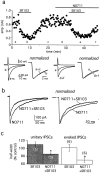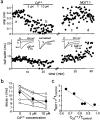Synapse density regulates independence at unitary inhibitory synapses
- PMID: 12684447
- PMCID: PMC6742076
- DOI: 10.1523/JNEUROSCI.23-07-02618.2003
Synapse density regulates independence at unitary inhibitory synapses
Abstract
Neurotransmitter transporters may promote synapse specificity by limiting spillover between release sites. At GABAergic synapses, transport block prolongs synaptic responses when many inputs are activated, yet it is unclear whether transporters alter signaling by single axons. We found that unitary IPSCs generated by paired recordings between hippocampal interneurons and granule cells could be either prolonged or totally unaffected by block of GABA transporters. This variability was explained by the density of active release sites rather than the number of active sites. Prolongation by transport block required release from multiple sites and was enhanced by repetitive activation. Furthermore, transport-sensitive unitary IPSCs were accelerated when the release probability was reduced, indicating that cross talk prolonged the time course of IPSCs even when transport was intact. Our results suggest that the release site density regulates the degree of cross talk as well as the contribution of transporters to GABA clearance. Thus, interplay between release site density and transporter action determines the independence of unitary inhibitory synapses.
Figures







Similar articles
-
Spillover-mediated transmission at inhibitory synapses promoted by high affinity alpha6 subunit GABA(A) receptors and glomerular geometry.Neuron. 1998 Apr;20(4):783-95. doi: 10.1016/s0896-6273(00)81016-8. Neuron. 1998. PMID: 9581769
-
Vigabatrin induces tonic inhibition via GABA transporter reversal without increasing vesicular GABA release.J Neurophysiol. 2003 Apr;89(4):2021-34. doi: 10.1152/jn.00856.2002. Epub 2002 Dec 27. J Neurophysiol. 2003. PMID: 12612025
-
Gephyrin is critical for glycine receptor clustering but not for the formation of functional GABAergic synapses in hippocampal neurons.J Neurosci. 2004 Jan 7;24(1):207-17. doi: 10.1523/JNEUROSCI.1661-03.2004. J Neurosci. 2004. PMID: 14715953 Free PMC article.
-
Generating diversity at GABAergic synapses.Trends Neurosci. 2001 Mar;24(3):155-62. doi: 10.1016/s0166-2236(00)01724-0. Trends Neurosci. 2001. PMID: 11182455 Review.
-
GABA transporter function in the horizontal cells of the skate.Prog Brain Res. 2001;131:267-75. doi: 10.1016/s0079-6123(01)31022-1. Prog Brain Res. 2001. PMID: 11420946 Review. No abstract available.
Cited by
-
Inhibition of NADPH oxidase within midbrain periaqueductal gray decreases pain sensitivity in Parkinson's disease via GABAergic signaling pathway.Physiol Res. 2020 Aug 31;69(4):711-720. doi: 10.33549/physiolres.934478. Epub 2020 Jun 25. Physiol Res. 2020. PMID: 32584140 Free PMC article.
-
Distinct synaptic properties of perisomatic inhibitory cell types and their different modulation by cholinergic receptor activation in the CA3 region of the mouse hippocampus.Eur J Neurosci. 2010 Jun;31(12):2234-46. doi: 10.1111/j.1460-9568.2010.07292.x. Epub 2010 Jun 7. Eur J Neurosci. 2010. PMID: 20529124 Free PMC article.
-
GABA transporter GAT1 prevents spillover at proximal and distal GABA synapses onto primate prefrontal cortex neurons.J Neurophysiol. 2009 Feb;101(2):533-47. doi: 10.1152/jn.91161.2008. Epub 2008 Dec 10. J Neurophysiol. 2009. PMID: 19073797 Free PMC article.
-
Localization and Function of GABA Transporters GAT-1 and GAT-3 in the Basal Ganglia.Front Syst Neurosci. 2011 Jul 28;5:63. doi: 10.3389/fnsys.2011.00063. eCollection 2011. Front Syst Neurosci. 2011. PMID: 21847373 Free PMC article.
-
Role for pro-inflammatory cytokines in regulating expression of GABA transporter type 1 and 3 in specific brain regions of kainic acid-induced status epilepticus.Neurochem Res. 2015 Mar;40(3):621-7. doi: 10.1007/s11064-014-1504-y. Epub 2015 Feb 24. Neurochem Res. 2015. PMID: 25708016
References
-
- Arnth-Jensen N, Jabaudon D, Scanziani M. Cooperation between independent hippocampal synapses is controlled by glutamate uptake. Nat Neurosci. 2002;5:325–331. - PubMed
-
- Asztely F, Erdemli G, Kullman DM. Extrasynaptic glutamate spillover in the hippocampus: dependence on temperature and the role of active glutamate uptake. Neuron. 1997;18:281–293. - PubMed
-
- Barbour B, Häusser M. Intersynaptic diffusion of neurotransmitter. Trends Neurosci. 1997;20:377–384. - PubMed
Publication types
MeSH terms
Substances
Grants and funding
LinkOut - more resources
Full Text Sources
